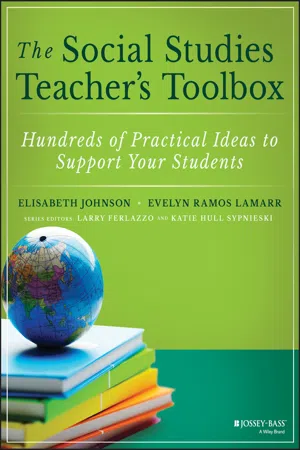
The Social Studies Teacher's Toolbox
Hundreds of Practical Ideas to Support Your Students
- English
- ePUB (mobile friendly)
- Available on iOS & Android
The Social Studies Teacher's Toolbox
Hundreds of Practical Ideas to Support Your Students
About this book
Social studies teachers will find classroom-tested lessons and strategies that can be easily implemented in the classroom
The Teacher' s Toolbox series is an innovative, research-based resource providing teachers with instructional strategies for students of all levels and abilities. Each book in the collection focuses on a specific content area. Clear, concise guidance enables teachers to quickly integrate low-prep, high-value lessons and strategies in their middle school and high school classrooms. Every strategy follows a practical, how-to format established by the series editors.
The Social Studies Teacher's Toolbox contains hundreds of student-friendly classroom lessons and teaching strategies. Clear and concise chapters, fully aligned to Common Core Social Studies standards and National Council for the Social Studies standards, cover the underlying research, technology based options, practical classroom use, and modification of each high-value lesson and strategy.
This book employs a hands-on approach to help educators quickly learn and apply proven methods and techniques in their social studies courses. Topics range from reading and writing in social studies and tools for analysis, to conducting formative and summative assessments, differentiating instruction, motivating students, incorporating social and emotional learning and culturally responsive teaching. Easy-to-read content shows how and why social studies should be taught and how to make connections across history, geography, political science, and beyond. Designed to reduce instructor preparation time and increase relevance, student engagement, and comprehension, this book:
- Explains the usefulness, application, and potential drawbacks of each instructional strategy
- Provides fresh activities applicable to all classrooms
- Helps social studies teachers work with ELLs, advanced students, and students with learning differences
- Offers real-world guidance for addressing current events while covering standards and working with textbooks
The Social Studies Teacher's Toolbox is an invaluable source of real-world lessons, strategies, and techniques for general education teachers and social studies specialists, as well as resource specialists/special education teachers, elementary and secondary educators, and teacher educators.
Frequently asked questions
- Essential is ideal for learners and professionals who enjoy exploring a wide range of subjects. Access the Essential Library with 800,000+ trusted titles and best-sellers across business, personal growth, and the humanities. Includes unlimited reading time and Standard Read Aloud voice.
- Complete: Perfect for advanced learners and researchers needing full, unrestricted access. Unlock 1.4M+ books across hundreds of subjects, including academic and specialized titles. The Complete Plan also includes advanced features like Premium Read Aloud and Research Assistant.
Please note we cannot support devices running on iOS 13 and Android 7 or earlier. Learn more about using the app.
Information
SECTION I
Reading and Writing
CHAPTER 1
A Fresh Look at Vocabulary
What Is It?
Why We Like It
Supporting Research
Common Core Connections
Social Studies Connections
Application
BUILDING A WORD LIST
Table of contents
- Cover
- Table of Contents
- List of Tables
- About the Authors
- About the Editors of the Toolbox Series
- Acknowledgments
- Letter from the Editors
- Introduction
- SECTION I: Reading and Writing
- SECTION II: Analysis Tools
- SECTION III: Speaking and Listening
- SECTION IV: Additional Key Strategies
- REFERENCES
- Index
- End User License Agreement